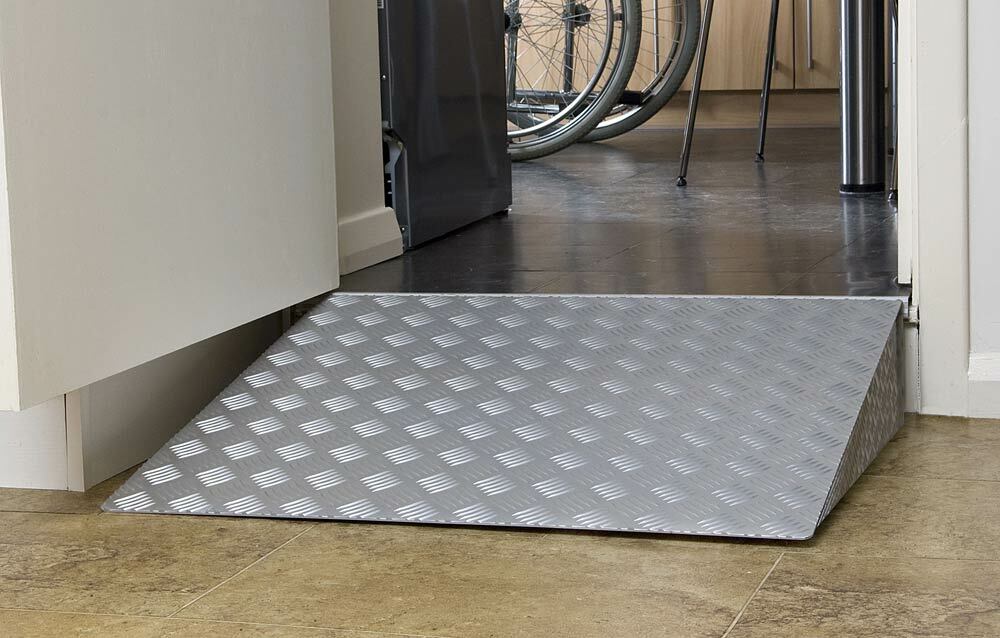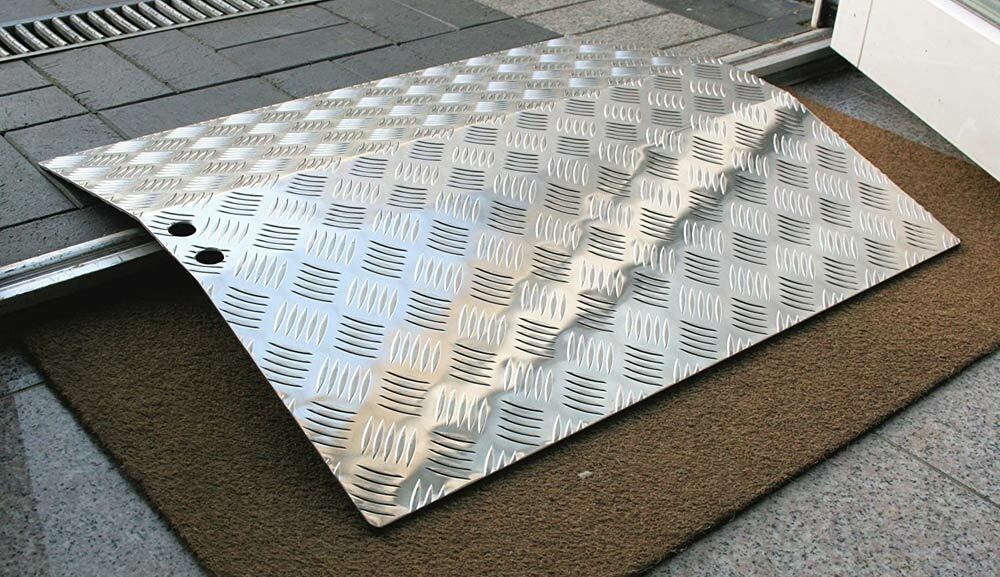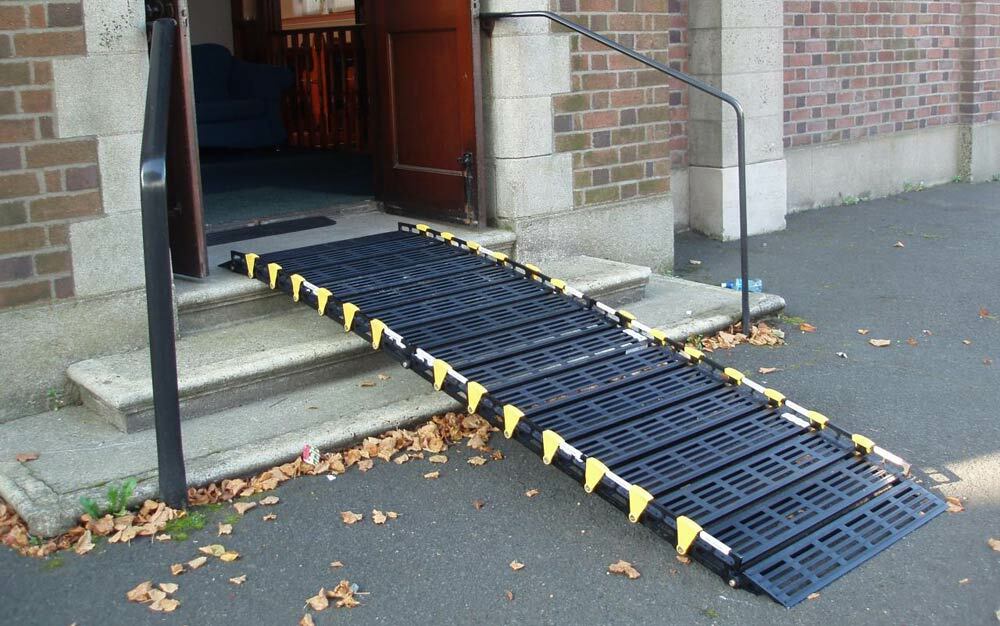In the article we will talk in detail about all types of factory ramps for wheelchair users, their features, advantages and disadvantages.
Modular ramps
Modular ramps are analogous to stationary metal ramps and practically do not differ from them in terms of their main characteristics.
Such as strength, dimensions, service life, ease of use, etc.
The only difference is that they are not welded in place from a metal profile, but are a prefabricated structure.
They are manufactured at the factory, and on site it is only necessary to assemble them for bolted and other connections.

Differences:
- You do not need to make a ramp from scratch, you only need to assemble the design calculated at the factory.
- Turnkey construction takes no more than 1 working day.
- At any time, the structure can be disassembled and reassembled at another place.
- It is not a permanent structure and does not require appropriate permits.
- Assembly does not require special professionalism and is within the power of employees of organizations with minimal skills in a similar field.
A modular ramp is assembled from separate parts. As a rule, platforms, ramps, handrails, supports, anti-slip coating are provided. It really depends on the manufacturer.
Where can be used:
Entrance groups to buildings and structures, in high rooms for access to the second floor.
Pros:
The speed of erection, collapsibility, factory quality, is not a capital structure.
Minuses:
The cost is usually higher than metal ramps assembled on site using welded joints.
Slightly less flexibility, since the geometry of the ramp is still bound by the size of the individual sections.
Application area:
Modular ramps are best used for typical entrance groups in rented premises.
When changing the rental location, you can transport the structure to another location and quickly install it.
Folding ramps
Folding ramps are located on the steps of the stairs only when necessary. The rest of the time they are parallel to the wall.
They are attached, depending on the design, to the wall, to the floor or to the wall and floor at the same time. However, most often you can find exactly models with several attachment points to the wall.
Factory drop ramps can be enamelled/powder coated steel or aluminium. The former are better suited for the street, as they are practically not susceptible to vandalism. Aluminum ones are more suitable for indoors, because they weigh much less and are much easier to use.

Where can be used:
Entrance groups and internal stairs in the premises.
Pros:
They do not occupy the flight of stairs when folded, they cannot jump off the steps, it is convenient to roll the stroller, quick and easy installation, affordable price, durability.
Application area:
Convenient for disabled people and people with prams. However, if you need a universal option for all types of strollers, you need to consider the width of the rails and the distance between them.
What to look for:
- In organizations, folding ramps are allowed to be used as a temporary measure until a major overhaul. Their use after a major overhaul is allowed only if it is impossible to make a full-fledged ramp.
- The rails must have an anti-slip coating. It can be corrugated or glued wear-resistant material.
- It will be difficult for disabled people, children and women to lay out a steel ramp due to its solid weight. Therefore, whenever possible, aluminum structures should be preferred.
Telescopic ramps
Ramps consisting of two rails, which in turn have several sections. For use, the ramp is placed at the top of the stairs, clinging to the upper step with a special tongue. Then, unfolding, descends to the bottom of the stairs.

Telescopic ramps are portable, so they are made only from anodized aluminum. Their weight is from 4 to 25 kg, and the length when unfolded is from 90 to 360 cm.
Where can be used:
Any stairs, the length of one flight of which is at least 10 cm less than the length of the ramp.
Minuses:
High cost, the possibility of displacement if installed incorrectly, the difficulty of transferring by hand and styling, limited length.
Pros:
Allow wheelchairs to climb stairs where other types of ramps are not provided. They can be used in various places, as they are available for transportation in transport (some models even in a wheelchair bag).
Application area:
Overcoming any stairs and high curbs on wheelchairs.
What to look for:
- It is necessary to measure the length of the flights of stairs for which the ramp is bought. And choose a model that is a little longer.
- On the inside of the ramps there must be an anti-slip coating (grooving or slips made of non-slip material).
- The length when folded must also be taken into account, since some ramps cannot be laid out in standard entrances.
Attached and rolling ramps
Two types of ramps that are designed to overcome thresholds and curbs. They are not suitable for stairs.
Attached - used for thresholds that rise above the floor on only one side. An attachment ramp is installed from it.
It is important that its height is the same as that of the obstacle (a discrepancy of no more than a few centimeters is allowed).

Peculiarities:
- It is difficult to choose a model suitable for the height of a particular threshold, curb.
- It is recommended to fasten the ramp to the floor in order to avoid its displacement (if the flooring is not slippery, then you can do without fixing).
- Suitable for indoors and outdoors.
There are also attached ramps with height adjustment. They are already more versatile, therefore they are more practical and easier to adapt to non-standard thresholds and curbs.
Rolling - used for obstacles that rise above the floor on both sides.
The ramp literally fits over the threshold.
It is desirable that the highest part of the ramp (in the middle) be the same height as the threshold. The discrepancy is possible only in the direction of increasing the height of the ramp (if it is even 1 cm lower, it will no longer be possible to use it).

Peculiarities:
- It is necessary to select a model whose height is approximately equal to the height of the threshold.
- Unlike attached ramps, erratic ones must be attached to the floor or threshold.
- Not suitable for outdoor use.
Among the rolling ramps there are also models with height adjustment. However, it should be borne in mind that increasing the height increases the level of inclination of the ramp, which complicates its use. Therefore, it is better to still select a model in which the minimum height fits the threshold.
Selection Recommendations:
- For rooms it is optimal to use aluminum models. They are lighter and have a more pleasant design, not much spoiling the interior.
- For the street, in turn, steel structures with powder coating or stainless steel products are better suited.
This is explained by higher strength and, as a result, vandal resistance. - On the outside of the ramps there must be an anti-slip coating in the form of a relief pattern or a special coating.
- Models with bumpers prevent the stroller from slipping sideways when the stroller is carelessly controlled. They are desirable but not required.
Roll ramps
Aluminum structures consisting of many narrow cells connected to movable fasteners. When folded, they are a roll with a diameter of 20 to 50 cm or more. When unfolded, they can have a length of up to 3 m.
They are used to overcome stairs, thresholds and curbs, to enter transport (minibuses, trolleybuses, buses, trains).
Thus, being an analogue of telescopic ramps.

Currently, roll structures are in low demand, as they are inferior to telescopic models in a number of characteristics.
Comparison with telescopes:
- When folded, they take up a lot of space and are more difficult to transport.
- With the same length, as a rule, they have a large weight (by 30-50%).
- Significantly higher load capacity (up to 500 kg).
- With equal length characteristics, the price is on average twice as high.
Another disadvantage is the integrity of the design. Because of what it is extremely difficult to lift, say, a wheelchair up the stairs. Since the accompanying person has to walk not along the steps, but along the ramp itself, which is difficult.
True, there are also rolled ramps, consisting of two parts, they are already much better suited for stairs.

Purpose:
Roll-up structures are inconvenient for climbing stairs and curbs due to their large folded dimensions, solid weight and, as a rule, a single design.
But for driving on high obstacles, they are even better, as it is safer and you do not need to measure the distance between the two guides. Therefore, they are often used to drive a wheelchair into a car, including when transporting disabled and bedridden patients.
Where can I buy
Factory-made ramps for the disabled are, as a rule, available in medical and rehabilitation equipment stores. For example, a large assortment of ramps of Russian, Chinese and European production is in the store Medtekhnika №1.
As a rule, factory designs are sold ready-made with certain dimensions. However, some models can be ordered with individual sizes, then they will be made to measure. But you have to wait a couple of weeks.


